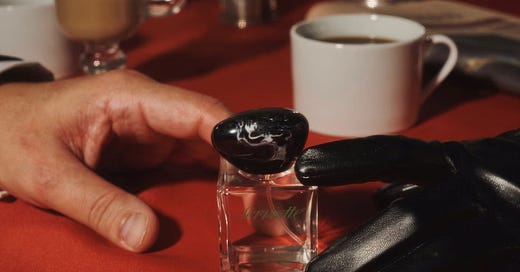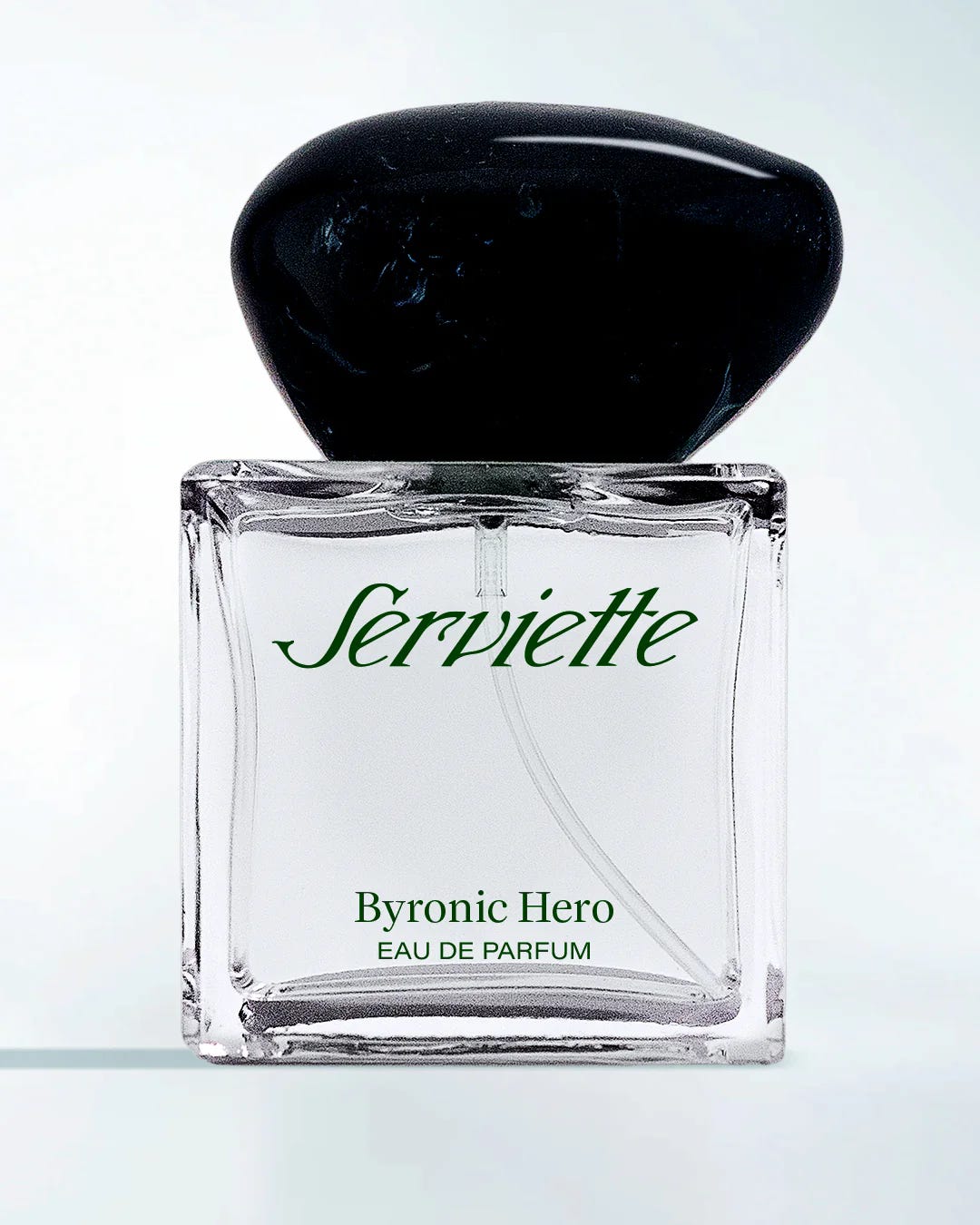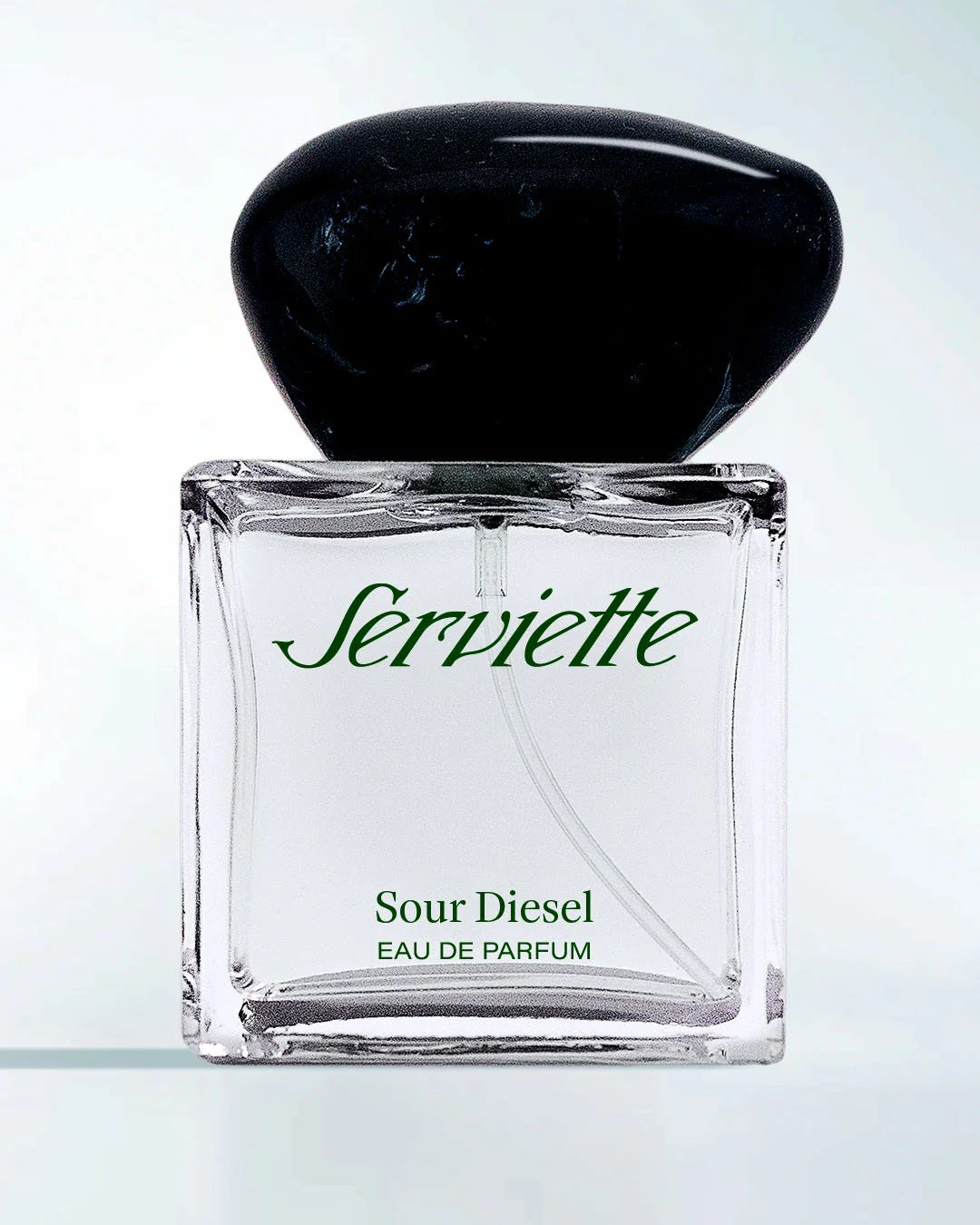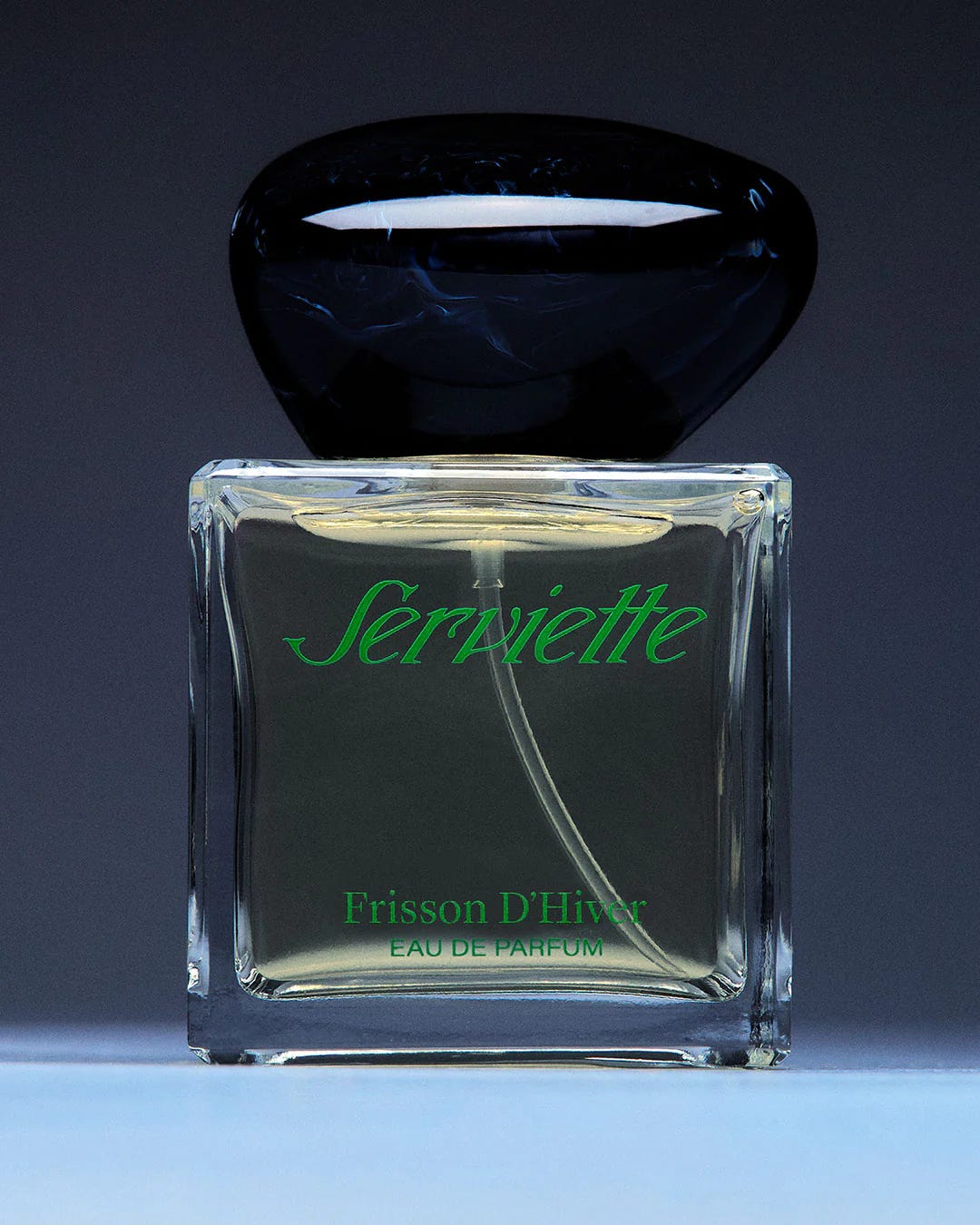Whose taste is good taste?
An examination of the consciously chic debut collection from NYC-based perfumer Serviette.
Hitting the ground running in the beginning of 2025, it seemed like the public launch of NYC’s Serviette perfume house was buttressed by everything from in-the-know editorial interviews to in-person launch events. In a market environment in which vast droves of pandemic perfumers are finally beginning to hone their DIY sensibilities into something able to seriously compete with established niche fragrance houses, these small details make or break a brand’s notoriety and success. First encountering the line in Manhattan’s hardcore scent enthusiast grindhouse Stele, I immediately noticed the sheer amount of design accoutrement put into these four simple perfumes by multi-hyphenate Central Saint Martins alum Trey Taylor. In many ways, it seems like these luxurious add-ons are the point of this marketing concept: surrounding four very easy to love sufficiently well-known niche scent genres with the materials to encourage the wearer to make them their own. I can see Serviette landing swimmingly with culturally literate young people looking to find their longtime signature scent, less collector’s-perfume a-la the small and antagonistically experimental bottles from small-batch perfumers like Jorum Studios. This is moreso something that looks best sitting on someone’s dresser, among the pictures and interior design choices that make their home space different from anyone else’s. Accompanied by a delicately embroidered handkerchief and a suitably heady latin motto “de gustibus disputari potest” (trans. ‘We can argue about good taste.’ A reversal of the maxim de gustibus non est disputandum or ‘there is no arguing about good taste’), I get the sense that Taylor is very consciously playing on industry markers of exclusionary beauty standards. From its very beginning, perfume as collectible or perfume as experimental art object has always belied the origins of perfume as a distinctly class-based commodity marketed to signal social standing. This reality is not far from even the most politically progressive fanatics. At the end of the day, most laypeople who develop perfume collection as a hobby must routinely allocate a large part of their discretionary spending to buying samples, collecting full bottles, etc - for those not already in the industry, this ‘community’ has a massive financial gateway to entry. The concept of taste is inevitably brought into this dynamic. People spending large amounts of money on perfume are to be dubiously assured by their specific product choices that they are not just able to buy expensive things because of their finances, but because of the caliber of their minds. It’s a subtle distinction, but one that often plays into the mystique behind how different types of perfume are able to win out over others in consumer spending habits. In this sense, it’s interesting how in the current market, perfume that smells stereotypically good, or feels appealing, pretty, and well-natured is often the cheapest mainstream designer option, and the most premium product people shill out large amounts of money for smells like damp earth, a spice cabinet, or pungent fermented oud.
It is in these contexts which I am considering the four perfumes that make up Serviette’s debut collection, four dainty 50ml eaux de parfums and a 2ml sample set that I think if nothing else, are absolutely worth your time and precursory exploration.
My immediate favorite, the suggestively named “Byronic Hero” is by far the least subtle fragrance in Taylor’s repertoire. Taking, as previously mentioned, a well known but tasteful genre: the rose-oud, and rendering it approachable and idiosyncratic. The main draw here is the stated diesel exhaust note. It is hardly airy and atmospheric like Chris Rusak’s AEOOJ (LMB), or aggressively metallic like Rubini’s Nuvolari. It more so reads to me like a cheese-like stink to accompany the spicy saffron-laden oud. I’m not always the biggest fan of rose notes, but here it’s the specific kind of oh-so-dramatically drippy jammy rose that makes me forget my many misgivings towards the queen of flowers. I see immediate similarities to the loud NoLiTa banger Notorious Oud from similar city kids DS and Durga. To me, saffron screams not only luxury, but young money. It is an essential wing of the decisively un-subtle Baccarat Rouge F-22 fighter jet that hasn’t let up on its nearly decade-long arial attack route on the clueless financially endowed women of corporate America. I am very much endeared to its use here, however. I could see this being the perfect perfume to turn heads at a lit-mag opening, but something I would equally want to wear at home on a rainy day. It is a suitable introduction to stylized oud for those looking to widen their tree tastes beyond the sweetness of sandalwood, but has that same sort of addictive coyly plastic astringency that made Vilhelm Parfumerie’s Faces of Francis one of my most worn perfumes of the last year. I think Byronic Hero does what Serviette does best, which is delicately tow the line between accessible and experimental in a hyper-stylized package that whispers longingly to be posted, retweeted, and shared. Perhaps not as moody as the name might suggest, I think it is absolutely full bottle worthy no matter your previous experience with oud wood or morbidly brooding poetry.
This was perhaps the most challenging entry in the collection to my nose. The opening was a very bare bones rhubarb, which I can always be convinced of. But then enters another fun fantasy accord: weed smoke. To be honest, my dad is a stoner and I am a catholic convert, so I don’t have the most experience or fond memories with cannabis. I don’t exactly get the skunk-like photorealistic essence of its smoke here, like I do in something like Filigree and Shadow’s amazingly skeezy YOUR LOVE INSIDE ME. Like Byronic Hero, this is more so a supporting herbaceous note for other more traditional accords, and here the accord is an almost fougère-like geranium and patchouli blend. Certainly earthy and green, I see only fleeting connections between its name, “Sour Diesel,” and its scent. I do absolutely think it possesses a sort of sour quality to it, which I think is very much appealing to the right person with the right, shall we say taste. I can see this wearing well on a tall man in distressed denim, it almost evokes the vibe of your older brother’s room in his teenage years. Not even just because of the weed, but because the watery sort of green notes somewhat recall similar herb based masculine compositions like Polo. If you’re the type of consumer to seek out orange wine on purpose, you might need to smell this. Not completely my style, but I think anything that can Trojan-Horse the tart smell of rhubarb into mainstream olfactory culture is something to be celebrated.
It took a second for this fragrance to grow on me, but grow it absolutely did. Ruche is perhaps the most difficult scent from the collection to nail down. It does not exist firmly within the boundaries of perfume I smell frequently. I loved hearing Taylor go on record saying this perfume started out as his attempt at constructing a naturalistic raspberry note. As one of my favorite fruits to eat, I’ve never fully been able to connect with raspberry on its own in perfume – as I think it often reads far more wet synthetic saccharine than dry powdery lipstick, as I would prefer it to. Here, however, I am far more impressed by seemingly mature undertones of creamy sandalwood and piquant pink pepper. This is a far cry from your average raspberry body mist, and instead evokes a sort of dandyish suited champagne charm. Indeed the first thing I thought of was the underrated fragrance Life of the Party by Clara Weale’s UK-based house Early Modern. They both evoke well dressed, spindly men, toasting endless glasses of fruity cocktails at undeniably reputable functions. Maybe the most immediately wearable of the four fragrances, I think there is a great deal more nuance here than one would expect at first glance of its notes. A base of galbanum keeps things green and not-too-sweet. This is a fruity perfume for people who like fruit, but shy away from its typical over-the-top representation in the mass market perfume counter. There is a through line of almost culinary bitterness here, that I somewhat see present in all of Serviette’s debut collection, creating the aforementioned impression of cultured maturity. All things considered, Ruche is an effervescent raspberry sandalwood scent that wears tepid and easygoing on the skin. If Jorum Studio’s enchanting Healing Berry is foraging feral wildberries, this is the most civilized possible version of the fruit.
This is the collection’s ace in its sleeve, and the one that clearly carries the most wow-factor in the currency of sample kit first impressions. I found the gorgeously titled Frisson d’Hiver (trans. winter chill) underwhelmingly delicate on paper, but once worn on skin, sprung to life in tones of aching musks and sweet white florals. Lily of the valley, my professed favorite flower of all time, is given centerfold treatment, but it is not necessarily a soliflore. I pick up supporting notes of creamsicle orange blossom a-la the super-sunny masterpiece Fleurs d’Oranger, and a cool minerality described by Taylor as an ice accord. My own mentor Matt Morris noted this before me, but despite its name, this is a deeply summery perfume. To be fair, I have yet to have the chance to wear it on a freshly snowed morning a-la a similar delicate winter floral l’Eau d’Hiver, but today, in freakishly humid Chicago June days, it cools me down like a fresh popsicle hewn from little white flower buds. Underlying the floral notes is an almost milky vanilla effervescence that reminds me specifically of Milkis soft drinks: not super sweet but mellow and almost yoghurt-like. I truly don’t think I could ever get tired of wearing something like this. It’s simple but smart, and brings a smile to my face as surely as spring flowers sprout up from underneath the snow. Other potential references are the viscously underrated Labdanum 18 from Le Labo - which wears like a silken pair of opera gloves, and certainly feels like Maurice Roucel reprising the sensual warmth of Musc Ravageur without any of the spice. Between this and Clue’s Dandelion Butter, I’m beginning to notice a microtrend of DIY perfumers trying their hand at floral gourmands, a type of perfume actually exceedingly rare, despite itself. It is here that I see Trey’s confessed mentor, my friend and longtime NYC-based perfumer Marissa Zappas’ hand most clearly. I am reminded of a similar sort of whipped cream florality I get from her amazing Carnival of Souls. As someone who used to be fairly vocally critical of gourmand notes, I am actually really excited by these types of perfumes. I think a fragrance like Frisson d’Hiver is sweet and inviting, but contains enough complexity to sidestep the body spray allegations and justify its price point.
What really charms me about how Serviette is presented as a brand concept is how far it feels from the aesthetic sensibilities of DIY. I think the current cultural moment is so inundated with autodidact perfumers that the aesthetics of having made something oneself are no longer novel enough to garner any sort of underdog sympathy. These are very cohesive, very professional looking bottles, that just so happen to have been made by one person in a single studio. If independent niche perfume is to feasibly compete with established designer and legacy niche houses, which I think it very much is currently doing, it need not rest too heavily on its own laurels. While I often do caution against relying too heavily on perfume houses who frontload eye-catching design to mediocre scent, vice versa, it is no longer enough to be able to make passably good perfume, you must be able to tell compelling stories alongside it, both in the realm of olfactory creation, and in the realms of visual product design. I think other examples of entrepreneurs and creatives currently dominating this game are many people I have already happily covered in my freelance career: Cherry Cheng from Jouissance, Laura and Caleb from Clue, Marissa Zappas and her new rebrand (with clear connection to Taylor), and among people I’m not actively friends with, houses like Stora Skuggan, Thin Wild Mercury, and FZOTIC. They all mix DIY fragrance sensibilities with a far more optimized visual presentation. I could, in joking theory, see any of these perfumes presented at a Nordstrom and not visually look out of sorts among abandoned bottles of Chanel Chance and endless YSL Libre flankers. It is these kinds of perfumes that make me genuinely excited to see the ten year industry consequences of the explosion of interest in perfume among a younger, more internet-savvy generation. With houses like Serviette at their disposal, I think the younger generation is well equipped to handle the onslaught of commodity fetishism lasciviously thrown their way, and to emerge celibate and victorious with a few unique bottles of something tasteful, nothing more nothing less.
‘Eat your Lipstick’ is a perfume blog by Audrey Robinovitz, @foldyrhands
Audrey Robinovitz is a multidisciplinary artist, altar girl, and self-professed perfume critic. Her work intersects with the continued traditions of fiber and olfactory arts, post-structural feminism, and radical orthodox theology. At this very moment, she is most likely either smelling perfume or taking pictures of flowers.










Love these reviews, Serviette has been on my to-sniff list for awhile now! Per the marketing imagery, I think I need to order samples for the next time I read some sad-girl literature.